Langurkhola leads the way: Sindhuli's first Nutrition-Friendly Health Facility prioritizes children's future
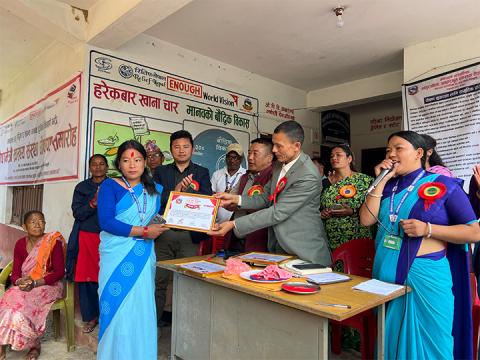
Tinpatan Rural Municipality, Sindhuli – In a landmark achievement for the Rural Municipality (RM), Langurkhola Basic Health Service Centre, Ward No. 10, has been officially recognized as a Nutrition Friendly Health Facility (NFHF). This momentous occasion marks it as the first among eleven health facilities in Tinpatan RM. This declaration underscores a profound commitment to the health and well-being of the community, aligning with national efforts like the Multi-Sector Nutrition Plan III (MSNP-III) and international goals such as Sustainable Development Goal (SDG) 2 (Zero Hunger) and SDG 3 (Good Health and Well-being), with a particular focus on the crucial nutritional needs of children, mothers, and adolescents.
This milestone is a significant stride within the broader Nutrition Friendly Local Governance (NFLG) framework, highlighting the dedication of local authorities and healthcare providers to embedding nutrition at the heart of health services. By achieving NFHF status, Langurkhola Basic Health Service Centre sets a powerful precedent for other facilities in the region to follow, contributing to initiatives like World Vision's ENOUGH Campaign that aims to end child hunger and malnutrition.
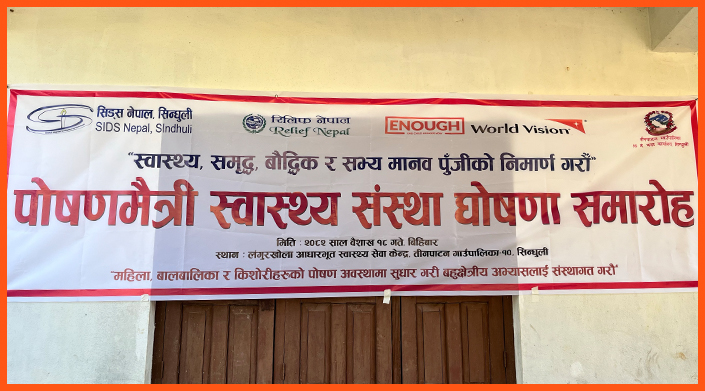
WHAT IS A NUTRITION-FRIENDLY HEALTH FACILITY?
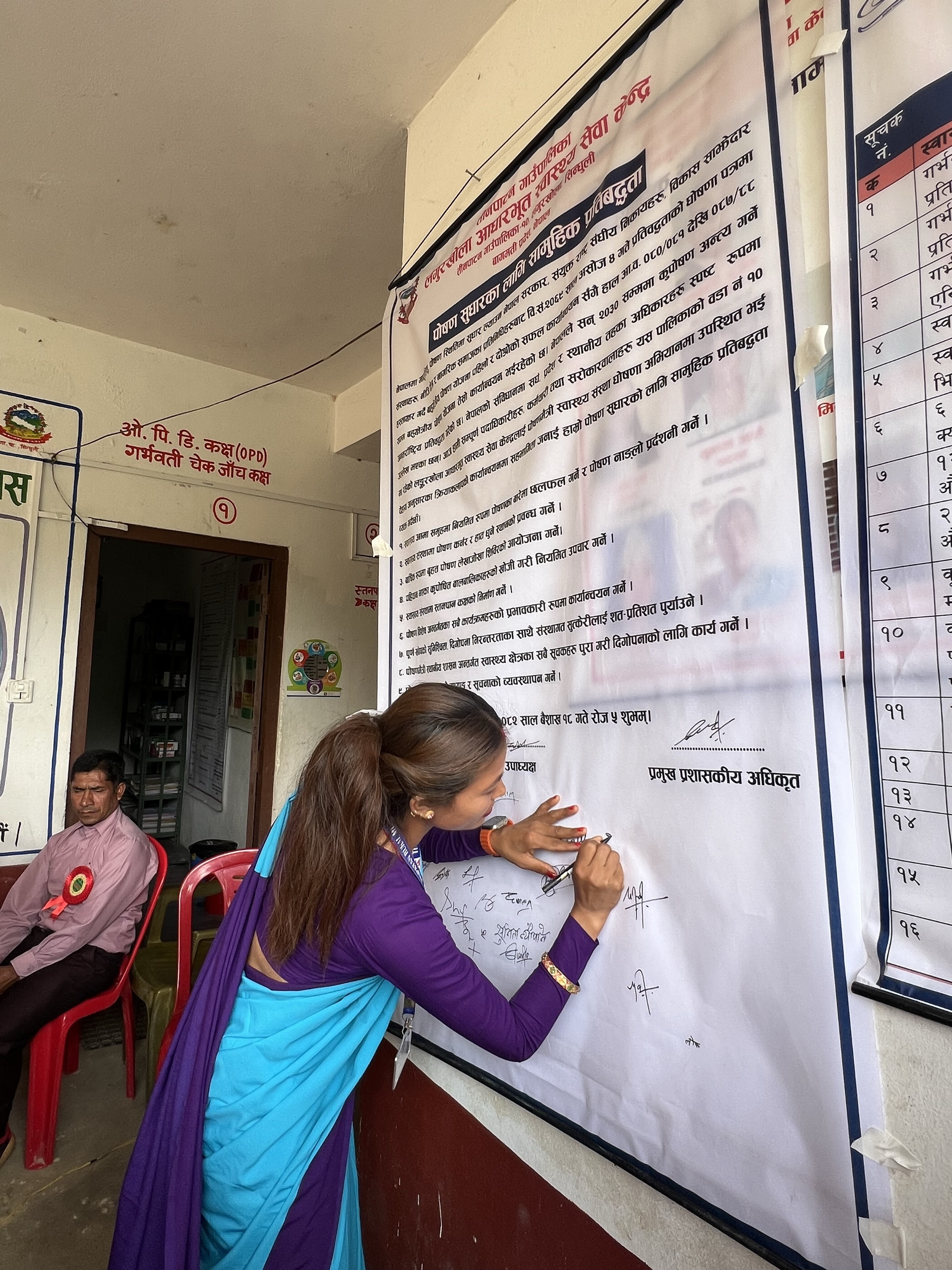
A Nutrition-Friendly Health Facility (NFHF) is a health centre that has been officially recognized for its commitment and active efforts to provide quality nutrition services as an integral part of its healthcare services. It's a facility that goes beyond basic healthcare to prioritize and promote optimal nutrition, particularly for vulnerable groups like pregnant and lactating mothers, infants, children, and adolescents. To achieve NFHF status, a health facility must meet specific criteria and standards that demonstrate its ability to provide routine nutrition assessments, offer counselling and support for breastfeeding and appropriate complementary feeding, manage malnutrition cases effectively, integrate nutrition interventions into other health services (like antenatal care, postnatal care, and child immunizations), ensure staff are trained in nutrition, and maintain adequate infrastructure and supplies for essential nutrition services.
In essence, an NFHF is a healthcare setting designed to actively contribute to preventing malnutrition and improving the nutritional well-being of the community it serves. Nutrition-Friendly Health Facilities are crucial for ensuring the health and well-being of both children and mothers. For children, these facilities provide essential services that prevent malnutrition and disease, support healthy growth and development, strengthen immune systems, and improve cognitive function. For mothers, NFHFs offer vital care and support during pregnancy, delivery, and postpartum, promoting maternal health and ensuring optimal nutrition and health for both mother and child.
WHY IS A NUTRITION-FRIENDLY HEALTH FACILITY SO IMPORTANT, ESPECIALLY FOR CHILDREN?
The first two years of a child's life are foundational for their physical and cognitive development. Adequate nutrition during this period is not just about survival; it's about laying the groundwork for a healthy and productive future. Malnutrition in children can lead to:
Impaired Growth and Development: Stunting and wasting can have irreversible consequences on a child's physical and mental capabilities.
Weakened Immune Systems: Malnourished children are more susceptible to infections and diseases.
Cognitive Deficits: Undernutrition can hinder brain development, impacting learning and educational attainment.
Increased Risk of Chronic Diseases: Early malnutrition can increase the risk of developing chronic diseases later in life.
A Nutrition-Friendly Health Facility plays a vital role in addressing these challenges by
Early Detection of Malnutrition: Health workers are trained to routinely assess the nutritional status of children through growth monitoring, allowing for timely intervention.
Providing Essential Nutrition Services: This includes promoting exclusive breastfeeding, appropriate complementary feeding practices, growth monitoring and promotion, prevention and management of malnutrition, and nutritional services for women during pregnancy and lactation. It also involves providing micronutrient supplementation to prevent anaemia, vitamin A deficiency, and iodine deficiency when needed. Prevention and management of infection and diseases: This involves regular immunization of children and timely diagnosis, treatment, and prevention of common infectious diseases like diarrhoea, pneumonia, measles, etc.
Educating Parents and Caregivers: NFHFs serve as crucial hubs for providing guidance and support to parents on optimal infant and young child feeding practices and healthy diets.
Managing Malnutrition Effectively: Facilities are equipped to manage and refer cases of severe acute malnutrition according to national guidelines.
Integrating Nutrition into Routine Care: Nutrition is not treated as a separate issue but is integrated into all relevant health services, such as antenatal and postnatal care, immunization, and child health check-ups.
HOW DOES A HEALTH FACILITY BECOME A NUTRITION-FRIENDLY HEALTH FACILITY?
The journey to becoming an NFHF involves a two-phased process with specific criteria that the facility must meet.
PHASE 1: MANDATORY CRITERIA
To begin the NFHF declaration process, health facilities must first fulfil 10 mandatory criteria that establish the foundation for providing quality nutrition services. These include:
A designated focal person for nutrition services is appointed from among the health workers.
The health facility has at least one trained staff member to provide specialized nutrition services.
The facility has adequate drinking water and sanitation infrastructure, including accessible and safe drinking water for all, accessible and clean toilets, and handwashing stations with soap and water in all service areas.
The facility is equipped with functional equipment for measuring children's growth, including weighing scales, height/length measuring boards, and MUAC tapes.
Essential nutrition-related medicines and supplies are adequately stocked, including vitamin A capsules, deworming medication, zinc tablets, Multiple micronutrient powder (Balvita) packets, iron-folic acid tablets, and ready-to-use therapeutic food (RUTF) (for Outpatient Therapeutic Center), with a minimum of one month's supply.
Nutrition-related information and education materials are displayed in visible areas for service users.
The facility maintains complete and up-to-date recording and reporting formats for nutrition-specific services, including child health cards, nutrition registers for children under two years of age, primary health care outreach clinic registers, Female Community Health Volunteer (FCHV) registers, health facility monthly reporting formats, and Integrated Management of Acute Malnutrition (IMAM) registers (if applicable). The Health Facility Operation and Management Committee (HFOMC) holds monthly meetings that include discussions on nutrition-related issues.
Nutrition service quality assessment checklists as per the Nutrition Service Quality Improvement Guidelines 2078 are utilized.
All nutrition-specific programmes are available at the health facility.
The health facility has established a nutrition corner.
The health facility meets the Sphere standards for the IMAM program (for outpatient therapeutic centres).
PHASE 2: NUTRITION-SPECIFIC SERVICE INDICATORS
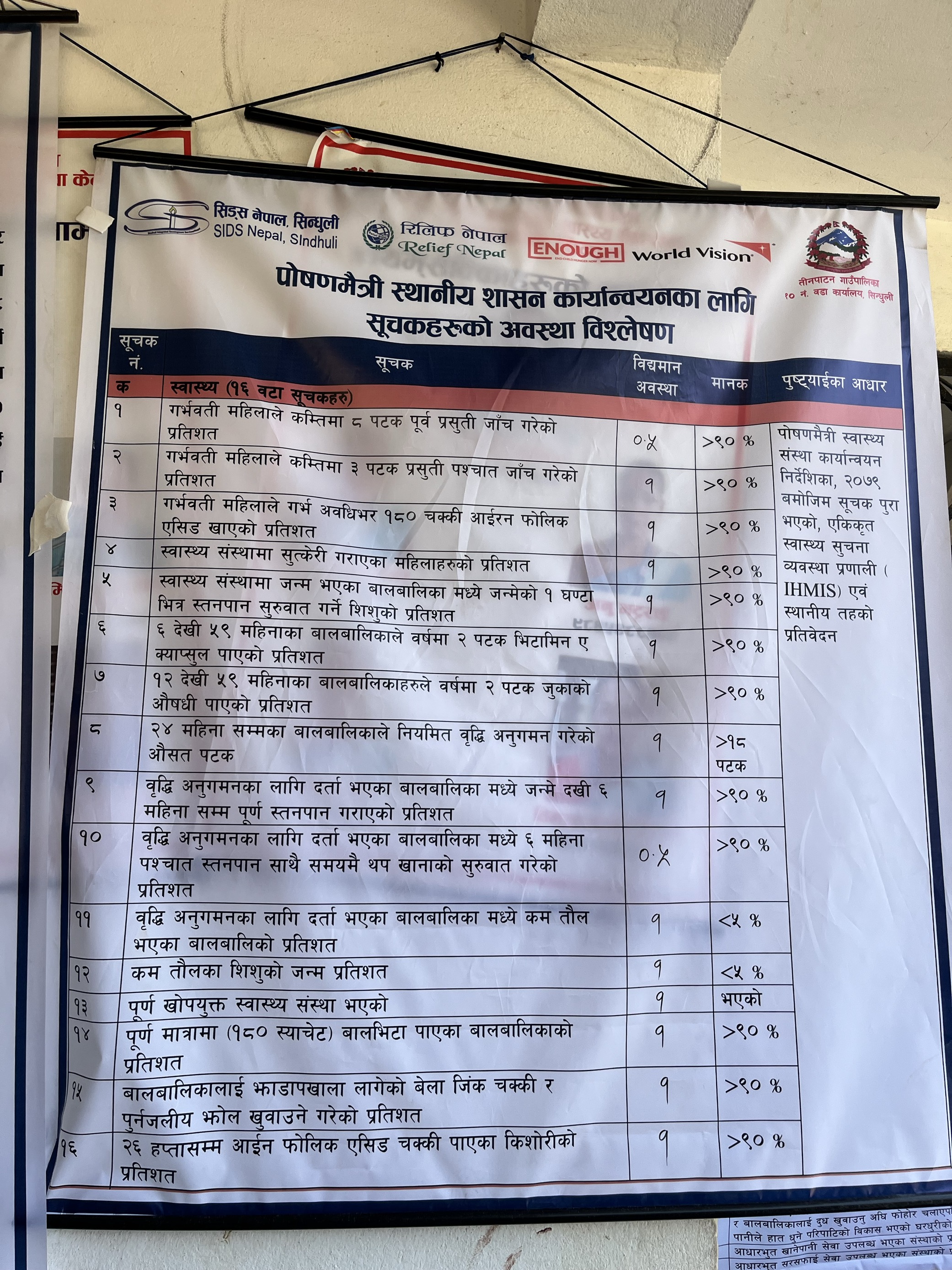
Once the mandatory criteria are met, the facility is assessed based on 16 key nutrition service indicators. These indicators evaluate the facility's performance in delivering essential nutrition interventions and are measured using data from the previous fiscal year, primarily from Health Management Information System (HMIS) records. These indicators cover critical areas such as antenatal and postnatal care , iron-folic acid supplementation during pregnancy, institutional deliveries and early initiation of breastfeeding, vitamin A supplementation and deworming for children under five years of age, exclusive breastfeeding and timely initiation of complementary feeding, low birth weight, number of underweight children, average growth monitoring of children under two years of age, immunization coverage, Balvita (a multiple micronutrient powder supplement distributed to children aged six months to two years) distribution, management of diarrhoea with zinc tablet and Oral Rehydration Solution (ORS), and iron-folic acid supplementation for adolescent girls. Facilities are scored based on their performance on these indicators, and those achieving a designated minimum score are eligible for NFHF declaration.
The declaration process involves the local health facility, through its Nutrition Service Quality Improvement Committee, conducting a self-assessment of its eligibility based on the mandatory criteria. Following this, the local level Quality Assurance Committee verifies the facility's self-assessment. Finally, the local government authority officially declares the facility as Nutrition Friendly if it fulfils all sixteen indicators.
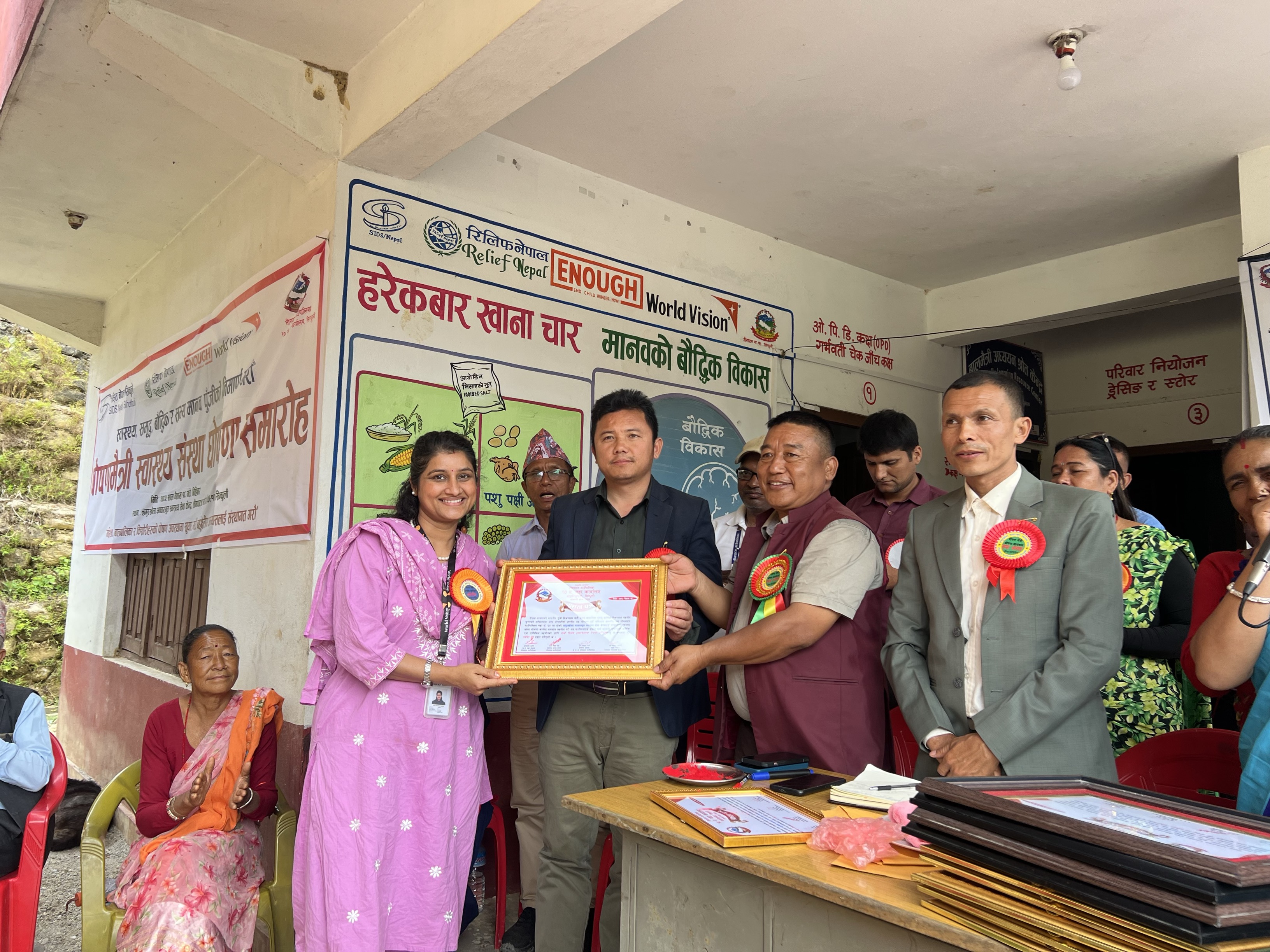
The declaration of Langurkhola Basic Health Service Centre as Sindhuli's first NFHF not only promises a healthier future for the children of the region but also serves as an inspiring example for other health facilities to prioritize nutrition and strive for similar recognition. It underscores the powerful impact of integrating nutrition into healthcare to build a healthier future generation and more resilient community.
Written by Binod Thapa Magar (Communications Specialist) and Pooja Pokhrel Mandal (Field Health and Nutrition Lead)